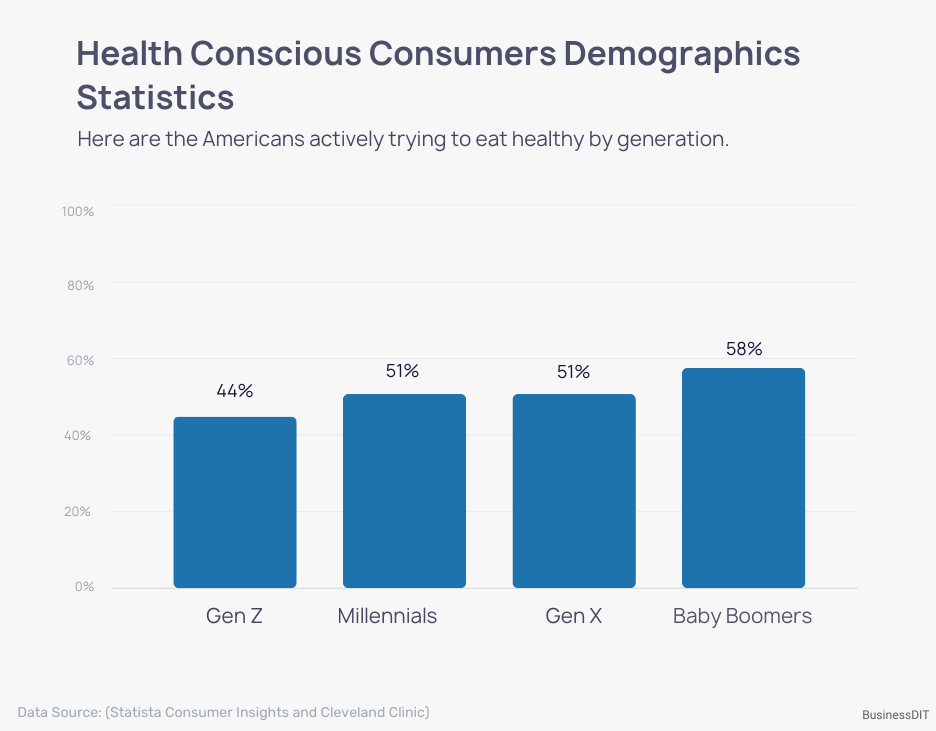33+ Key Health-Conscious Consumer Statistics For 2024
The health-conscious consumer is taking over the market, and businesses need to notice.
With half of Americans trying to eat healthier and 62% saying healthiness is a top factor in their food and drink purchases, it’s clear this trend is huge. So, why should businesses care about health-conscious consumers?
With that in mind, we’ll dive into 33+ key insights about health-conscious consumers statistics to help your business stay ahead of the curve.
Health Conscious Consumer Statistics: Key Numbers
- 50% of Americans claim to actively try to eat healthy.
- 62% say healthfulness is a key driver for food and beverage purchases.
- Over 70% of Americans are more conscious of their physical health after the COVID pandemic.
- 73% of consumers plan to eat and drink more healthily after the pandemic.
- 60% say the content they find on social media about food and nutrition has encouraged healthier choices.
- 63% of Americans say they consider whether the food is processed before purchasing it.
- 56% of those who prioritize healthy eating consume organic foods.
- 40% of consumers are cooking more meals at home to have greater control over what they eat.
- 93% say they feel compelled to eat healthy, at least some of the time. 63% say they try to eat healthy most, if not all, of the time.
- 1 in 4 consumers actively seek health benefits from foods.
Sources: (Statista Consumer Insights, FoodInsight, McKinsey, Pew Research Center, Consumer Food and Beverage Survey By L.E.K 2018, Food and Health Survey 2019, Nutrisystem and OnePoll, DSM)
Perceived Barriers to Eating Healthy Statistics
Eating healthy sounds great in theory, but it’s a different story in real life. Many people find it too expensive and just don’t have the time to prepare healthy meals. On top of that, there’s a lack of knowledge and willpower that makes it even harder. Here are the main challenges people face when trying to eat healthy:
- 46% of consumers say healthy eating is too expensive.
- 23% of consumers say that there is too little time to cook or prepare healthy meals.
- 20% of consumers say that there is a lack of knowledge on how to eat healthy.
- 44.6% reported a “lack of willpower” as a barrier.
- 42.9% reported a “busy lifestyle” as a barrier.
- 31.5% reported “irregular working hours” as a barrier.

Sources: (National Library of Medicine, Statista Consumer Insights and Cleveland Clinic)
Health Conscious Consumers Demographics Statistics
Here are the Americans actively trying to eat healthy by generation.
- 44% of Gen Z
- 51% of Millennials
- 51% of Gen X
- 58% of Baby Boomers

Sources: (Statista Consumer Insights and Cleveland Clinic)
Health Conscious Market
The health-conscious market is booming as more people focus on wellness and healthy eating. This global trend is pushing the market value up, with a noticeable jump in plant-based foods. Here’s a snapshot of how this shift towards healthier choices is shaping up:
- The global health and wellness food market is projected to increase to $1.1 trillion by 2027.
- The wellness market has grown at a rate of 5 to 10 percent per year in the United States, reaching $480 billion.
- U.S. retail sales of plant-based foods have grown 11% in the past year, bringing the total plant-based market value to $4.5 billion.

Sources: (Plant Based Foods Association, Business Wire, McKinsey)
Demand for healthy food statistics
People are really starting to care more about their health when it comes to food choices, and it’s changing how they shop. They’re looking for natural ingredients and foods that do more than just fill you up. Plus, there’s a growing awareness about the impact of added sugars, leading to new shopping habits:
- Even with inflation, 84% of consumers prioritize health and wellness when purchasing fresh food.
- 65% of consumers prefer natural ingredients in their food products.
- 55% of consumers are interested in foods that provide health benefits beyond basic nutrition.
- 50% of consumers are looking for healthier snack options.
- 75% of consumers are aware of the health impacts of added sugars and try to limit their intake.
- 45% of consumers prefer to buy organic products whenever possible.
- 62% of consumers have changed their shopping habits to prioritize healthier food options.
Sources: (Deloitte, Smarteam Market Research)
How Health-Conscious Consumers are Shaping the Food Industry (Statistics)
Health-conscious consumers are shaking up the food industry in big ways. People are more willing to spend on healthier options and want clear labels to know what they’re getting. This shift is making companies rethink and improve their products to keep up. Here are some key stats:
- 67% of consumers are willing to pay more for foods and beverages that promote health and wellness.
- 75% of consumers want to see clear labeling on food products indicating their health benefits.
- The health and wellness food market is expected to grow at a CAGR of 6.7% over the next five years.
- 60% of consumers prefer products with natural ingredients over synthetic ones.
- 55% of consumers consider the environmental impact of their food choices.
- 30% of consumers use digital platforms to learn about the health benefits of different foods.
- 45% of food and beverage companies have reformulated their products to reduce sugar, salt, and unhealthy fats in response to consumer demand for healthier options.
